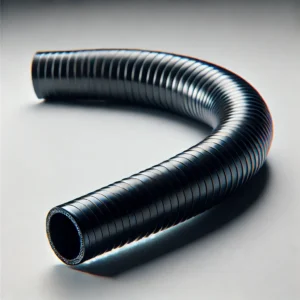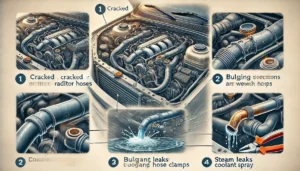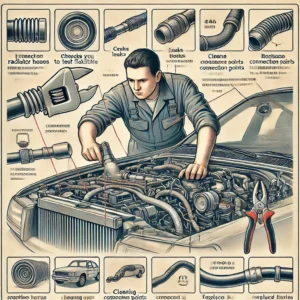The Essential Overview to Radiator Hoses:
Best for Effective Engine Air Conditioning
What is a Radiator Hose?

- Carries warm coolant from the engine to the radiator for air conditioning.
- Transports cooled down coolant back from the radiator to the engine.
Secret Features of a Radiator Hose

- Made to hold up against heats, usually varying from -40 ° F to 275 ° F.
- Flexible enough to accommodate engine vibrations and movements without damage.
Leak-Proof Design
- Watertight Design Attributes clamps and protected links to avoid coolant leakages.
- Constructed to deal with direct exposure to coolant chemicals and various other automobile liquids.
Kinds Of Radiator Hoses

One of the most usual kinds consist of:
Molded Radiator Hoses
- Custom-shaped to fit specific vehicle models.
- Pre-formed for precise installation.
Flexible Radiator Hoses
- Universal hoses with accordion-like designs for flexibility.
- Suitable for vehicles with varying hose lengths or unusual configurations.
Silicone Radiator Hoses
- High-performance hoses often used in racing or high-temperature environments.
- More durable and heat-resistant than standard rubber hoses.
Bypass Hoses
- Smaller hoses that allow coolant to bypass the radiator during warm-up periods.
Heater Hoses
- Carry coolant to and from the heater core to regulate cabin temperature.
- Common Problems with Radiator Hoses
Cracks and Splits
- Over time, radiator hoses can crack due to heat, pressure, or age.
- Visible cracks are a clear sign of damage and require immediate replacement.
Bulging or Swelling
- Excessive pressure or exposure to oil can cause the hose to swell, reducing its efficiency and risking a burst.
Leaks
- Leaking coolant from a hose can lead to overheating and engine damage. Check for wet spots or puddles under the vehicle.
Soft or Spongy Texture
- Hoses that feel unusually soft or mushy may be deteriorating internally, compromising their performance.
Collapsed Hoses
- A collapsed hose restricts coolant flow, often caused by a clogged radiator or a faulty thermostat.
Warning Signs of a Failing Radiator Hose

- Hot Engine The engine can overheat if the coolant hose is damaged or leaks.
- Coolant Spills: Small puddles under cars or trucks of orange or pink eco-friendly liquid indicate a leakage.
- Heavy steam from the Hood: A fractured hose can cause noticeable vapor leaving from the engine bay.
- Reduced Coolant Levels: A malfunctioning hose might lead to constant loss of coolant.
- Noticeable Damage: Cracks, protrudes, or endure the hose’s surface area signal it’s time for substitute.
Read About : fuel hose
How to Choose the Right Radiator Hose

When you are going to selecting a radiator hose, consider the following factors:
-
- Regular inspections are needed
- Check hoses for cracks and wear when performing routine maintenance.
- Hoses that Feel Good
- Squeeze the hoses gently. Hoses must be firm but not too soft.
- Monitor Coolant Levels
- Low coolant levels hose may indicate a problem with the cooling system, like a leaking hose.
- Flush the cooling system
- To avoid corrosion or clogging, replace and flush your coolant as needed.
- Replace worn-out hoses
- Hoses should be replaced after every four to five years for best performance or as recommended by the manufacturer or ask someone expert for tips.
- Regular inspections are needed
How to Inspect and Maintain The Radiator Hoses

- Inspections are required regularly
- When performing routine maintenance, check hoses to see and confirm if they show signs of cracks or wear.
- The Hoses Feel Good
- The hoses should be squeezed gently. The hoses should be firm, but not too hard or soft.
- Monitor Coolant Levels
- A low coolant level may be an indication of a cooling system problem which you need to take care of it, such as a leaky hose.
- Flush the cooling system
- Replace and flush the coolant regularly to avoid corrosion and clogging.
- Hoses that are worn out should be replaced
- Replacing hoses is recommended after every 4 to 5 years for best performance, or according to the manufacturer’s recommendations.
How to Replace a Radiator Hose

Replacing a radiator hose is a straightforward task if you follow these steps you will get what you need read carefully :
- Gather Tools and Materials
- New radiator hose
- Hose clamps
- Screwdriver or pliers
- Coolant
- Bucket or drain pan
- Drain the Coolant
- Place a bucket under the radiator drain valve and release the coolant.
- Remove the Old Hose
- Loosen the clamps carefully and carefully detach the hose from the radiator and engine.
- Install the New Hose
- Slide the new hose into place and secure it with clamps.
- Refill the Coolant
- Refill the radiator with coolant and check for leaks.
- Run the Engine
- Start the engine and let it warm up. Check the hose for proper installation and ensure there are no leaks.
Benefits of High-Quality Radiator Hoses
- Improved Engine Performance
- Ensures consistent coolant flow, preventing overheating and optimizing engine efficiency.
- Longer Lifespan
- Durable materials resist wear and tear, reducing the need for frequent replacements of hose .
- Cost Savings
- Prevents costly engine repairs caused by overheating or coolant leaks.
- Peace of Mind
- Reliable hoses reduce the risk of unexpected breakdowns on the road.
Top Brands for Radiator Hoses
- Gates
- Known for high-quality molded hoses and innovative designs.
- Dayco
- Offers durable hoses with excellent heat resistance.
- ACDelco
- Trusted for OEM-quality parts suitable for a wide range of vehicles.
- Mishimoto
- Specializes in silicone hoses for high-performance applications.
- Continental
- Provides reliable and long-lasting radiator hoses for your projects.
FAQS frequently asked by people
Q1.What is the cost of replacing a radiator tube?
- The cost of a replacement hose can range between $100 and $300 including labor and parts, depending on where it is located and the type of vehicle.
Q2.What is radiator hose?
- A radiator hose is a versatile tube that links to the engine and radiator to allow coolant to circulation in engine to maintain its temperature. It also manages the temperature of the engine.
Q3.Is it safe to drive with a damaged radiator hose in my auto?
- No. Coolant can leak from a faulty hose which have leaks or any other problem, triggering engine getting too hot.
Q4.What’s a radiator leak?
- When the hose ruptures or fractures it can create coolant to leakage, which might result in engine overheating and make problem for engine health.
Q5.How can you tell if your radiator hose is damaged?
- Overheating of the engine, coolant pools under the car, and noticeable splits, protrudes, or splits in the hose are all signs.
Conclusion
Radiator hoses are basic, yet they’re essential for your automobile’s air conditioning system. They likewise boost its efficiency. Recognizing their objective, identifying indications of wear and preserving them properly will assist you stay clear of pricey repair services. If you have an auto, a top quality radiator hose is a great financial investment.
Your engine will certainly stay in excellent problem with routine examinations and substitutes. You’ll have the ability to delight in cooler and much more effective experiences for several years with the right radiator hose!